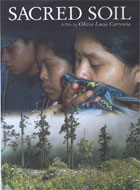
Sacred Soil 2008
Distributed by Icarus Films, 32 Court St., 21st Floor, Brooklyn, NY 11201; 800-876-1710
Produced by Olivia Lucia Carrescia and Holly Martin Montufar
Directed by Olivia Lucia Carrescia
DVD, color, 22 min.
Sr. High - Adult
Anthropology, Central American Studies, Criminal Justice, Death and Dying, Human Rights, Political Science
Date Entered: 08/20/2009
Reviewed by Wendy Highby, University of Northern ColoradoIn Sacred Soil, director Olivia Lucia Carrescia, follows up her Mayan Trilogy: Life, Death & Migration by documenting the work of the Forensic Anthropology Foundation of Guatemala (FAFG). The film witnesses the exhumation, identification, and reburial of a victim of the October 2005 mudslide in the village of Panabaj, Santiago Atitlán, Sololá, Guatemala. However, the majority of FAFG’s work involves victims of the political violence in Guatemala’s multi-decade internal conflict (particularly in the Quiché department). Various aspects of the forensic process are shown, including social anthropology (research, interviews, and meetings with survivors), archaeology (exhumation), and physical anthropology (analyses of remains). Sacred Soil features extensive interviews with FAFG Executive Director Fredy Peccerelli. An articulate spokesperson, Peccerelli explains the importance in Mayan culture of the establishment of proper communication between the dead and the living. He emphasizes that trust, sensitivity, and egalitarianism are key in the relationship between the forensic team and the community in which it works.
Peccerelli frankly discusses the obstacles and threats faced by the organization, including lack of funding, death threats, length of time elapsed, and difficult sites. Of the 160,000 persons known dead in Guatemala’s civil war, only 5,000 have been recovered. He stresses that the process has community solidarity behind it. He affirms, “. . . the way to change Guatemala is to discover and uncover its past.”
The film is an excellent classroom introduction to forensic anthropology and thus, is supportive of both anthropology and criminal justice curriculum. It is instructive regarding cultural sensitivity and bereavement. It also supports area studies, human rights studies, political science, and sociology curriculum.